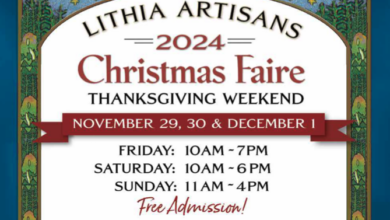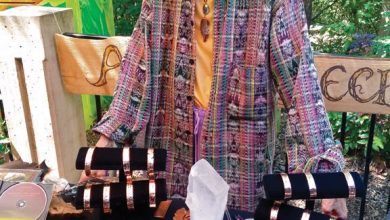The Hat People
I recently had the opportunity to visit the Hat Ranch — the home of Jim and Carol Young. They are a unique partnership both as a married couple, and the owners of “Hat People”. The Hat People are the most senior members of the Lithia Artisans Market, active members for 24 years. The three of us took a walk through their quarter acre of organic gardens, then sat down to a meal featuring fresh picked veggies, shrimp, and homemade bread. I turned on the tape recorder (my latest yard sale find) and we began to talk…
How long have you been living in the Ashland area?
Carol…We have been living out here at the Hat Ranch since 1985. Our oldest son Jacob was 6 years old when we moved here. Rose, our youngest, was born here on the farm.
Why do you call your two acre property the “Hat Ranch”?
Jim… Frank Zappa had a song about going to Montana to harvest dental floss from the dental floss bush. That song inspired me to call our place the Hat Ranch.
How long have you been a part of the Lithia Artisans Market?
Jim… Since the inception. I helped found the Lithia Artisans Market. There are only a couple of artisans left from those days.
Before the existence of the Lithia Artisans Market there was a different Saturday Market. Tell me what you know about that?
Jim… That was called the Ashland Marketplace and was run by Wink Jean and Ruth Ann Almquist. I believe it was Ruth Ann who actually started the market in 1982.
Carol… We used to bring our hats to the market from our place in Silver Creek.
Where is Silver Creek?
Carol… Silver Creek is 35 miles west of Merlin, above Grants Pass, out in the middle of nowhere in the coastal range. The closest settlement is Galice. We lived in a small cabin that was build in 1945 on an old gold mine claim. There was no electricity.
We met in November of ’76. We were both artists, Jim was an oil painter, I was doing sketch art. In April of 1977 I matted up a bunch of my drawings and took them down to Saturday Market in Portland and set up under the Burnside Bridge. I didn’t sell any drawings but I did trade for two little caps made of blue jeans. We got married in July and we always wore these little blue jean caps, with a pocket on top. All of our friends wanted the hats so I figured I would get some “free box” material and make some hats. We got old irons and cut the cords off of them and heated them on the wood stove. Jim would iron the denim and I would use an old hand crank sewing machine to sew our hats.
We would load up a duffle bag full of hats and run around in our baja bug and pull them out in parking lots and sell hats. We would occasionally borrow ten bucks and go to Eugene or Portland to the Saturday Market. We were trading, selling, making a little money and we did it with all free material. It was sort of miraculous.
Why did you call your business Hat People?
Carol… At one point it was going to be called “Heavy Lids,” but that had too much of a connection to marijuana. Then we met this couple who played the blues, Thadious and Sandabeth. We made her a special hat that was a copy of a hat that had been her mother’s. Anyway, they wrote us a letter that said, “those amazing Hat People in Merlin.” That is when we became the Hat People.
How long have you been making hats?
Jim and Carol together… For 33 years.
Are you completely self taught?
Carol… I learned to sew in junior high school.
Jim…Developing the patterns was all trial and error. Those ideas sort of found us.
Tell me about marketing, what is that like?
Carol… I think we did well from the beginning because Jim just had a knack for marketing. Maybe that has something to do with his working at his dad’s furniture store in Brookings, Oregon as a young man. Jim used to take his paintings to Spring Faire and sell out. Selling all your art is an artist’s dream. There he is selling to broke hippies from Wolf Creek and folks from the boonies of Oregon.
He appealed to the highly psychedelicized people, and this was the early ’70’s. Jim painted polygons, multi-sided canvasses with wild subject matter. One was a strange purple cat with glaring gold eyes. Very abstract landscapes, with mirrors of color. It was nothing normal even by todays standards.
Do you miss being a painter?
Jim… One of the things that happened to me was that I had a cumulative condition where I was poisoned by the paints. I did a lot of painting using my hands. It got so whenever I was around oil paints I would have a reaction, I would get a headache. I really loved to paint, but it was making me sick.
Carol.. That is one of the reasons Jim got into computers and photoshop.
Jim… Photoshop is very painterly.
How did you end up where you are today with a studio at the Briscoe ArtWing, and one of the most successful artisan micro-industries in southern Oregon?
Jim… About 10 plus years ago we lauched our website, www.hatpeople.com. We used to do everything out here at the Hat Ranch, but then the online thing started to take off about 6 years ago. It got to be too much with shipping and everything. At that time the Briscoe Elementary School was being decommissioned. My friend Debbie Lorray wanted to make part of the old school into art studios. She needed a non-profit to help make that vision a reality. She approached me as I was the Chairman of the Board of Lithia Arts Guild of Oregon. I still am today.
I got involved in the project and we devised a way to keep the rent low for artists by supplementing the rent with volunteer hours and paying a percentage of all sales to the Ashland School District. When we have a show at the ArtWing like MidSummers Dream or Holiday Market, 4% of all sales go to the district. The ArtWing gives 270 volunteer hours to the school district; however, last year we logged 405 hours. The kids love it, the teachers love it, the ArtWing residents love it too.
So, the ArtWing gives students a true view of what it means to be a working artist or artisan?
Jim… It is more than that. After working with the students for a few years now we have really come to understand the importance of art in the curriculum. It teaches the creative process. Once a student learns the creative process they can apply that to anything. Essentially the creative process is the foundation of all innovation. That is, you have to see something new in your mind then you have to have the wherewithal and the confidence to gather the tools and materials and then produce whatever it is that you see. That process applies to any walk of life and any discipline. That creative process is taught best through art.
How does that creative process model work with politics and community?
Jim…That is the art of community. That is one of the most difficult areas there is for the creative process. Essentially you are trying to see where a community needs to go in its evolution, then bring the people together through the process of consensus. Any political process or community work cannot be done by one person. It takes people coming together and seeing what the process looks like, collectively, through consensus. Everyone needs to share the vision of where we need to go then everyone knows how to grab hold. When everyone sees the vision clearly they know how to plug in with their special skills to make that vision a reality. Communicating, understanding a shared vision is not an easy task. As you present the vision to the community that gives the community the opportunity to mature the vision, to evolve the vision into something that really works for everyone. The more people that see the vision, that understand what needs to be manifest, the more hands that you bring to bear in creating the thing. We are talking about the creative process again. The art of community, the art of rocket science, the art building a locomotive, it is all about the creative process.
So, when you take away art from the school curriculum, you are restricting that creative process.
Jim…That trend has now been documented. The creative process is something that is taught, just like math, writing. Understanding the creative process takes practice. For the last ten years our childrens ability to engage in the creative process has become more and more stagnated which decreases innovation.
That is why I believe that the work of places like the ArtWing, the work of art in schools, is way underrated. It is so important. Look at me up on my soapbox again.
Carol… Well, that is one of your main messages.
The Lithia Artisans Market is the vehicle for the communtiy to come together and show what their creative process has manifested. What is it that you most appreciate about that vehicle?
Jim…There were more small businesses created during the depression then at any other time our nations history. People couldn’t find jobs so they started to create their own jobs and that is how they got through the depression. Today we are so dependent on huge corporations, and when they make a mistake it affects thousands of people. The result of those mistakes is the economic downturn we are experiencing today.
What the Lithia Artisans Market does is provide a vehicle for small manufacturing businesses to experiment, to see if the idea works. It is so important to the health of the economy because it returns the dollars, the power back to the community. It is a minimal investment to become a member and you can check it out and see if it works for you. Sometimes people start here and then move way beyond the artisans market. Some take their idea worldwide. Even Hat People is worldwide now, we ship hats all over the world. We still love showing our hats at the Lithia Artisans Market because it is our roots, it is our community, and I am all about community.
Learn More At:
Lithia Artisans Market
April – November
Saturdays 10am – 6pm
Sundays 11am – 5pm
Hat People
PO Box 722
Talent, OR 97540
HatPeople.com



